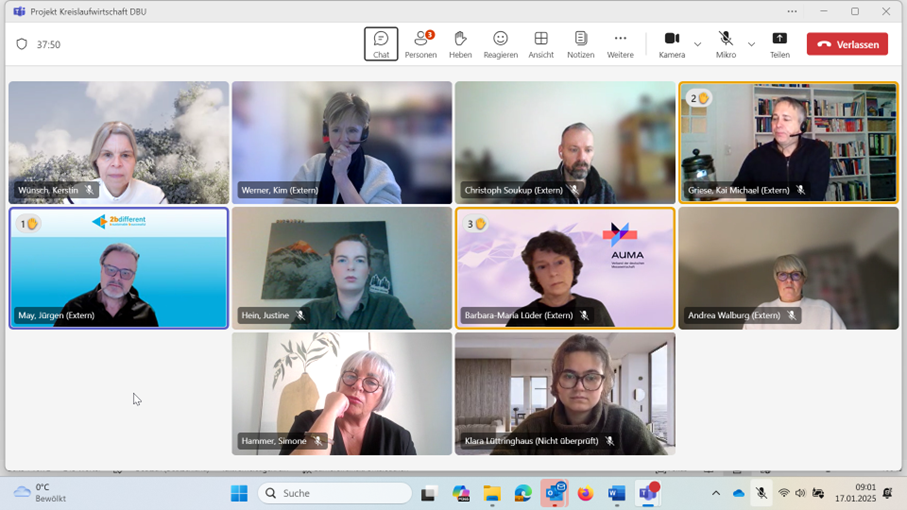
Circular Collective
New DBU project

The partners of the new "Circular economy in the trade fair industry" project funded by the German Federal Environmental Foundation (DBU) at the kick-off meeting in January. Image: tw tagungswirtschaft, Kerstin Wünsch
The partners of the new "Circular economy in the trade fair industry" project funded by the German Federal Environmental Foundation at the kick-off meeting in January. Image: tw tagungswirtschaft, Kerstin Wünsch
Fairs are an important platform for showcasing products and opening up new markets, but they also contribute to waste and emissions. Circular business models play a key role in reducing, recycling, and recovering waste. The Circular Economy in the Trade Fair Industry project, funded by the German Federal Environmental Foundation, is exploring how these models can be implemented and developing actionable recommendations for small and medium-sized companies. The project includes the "circular exhibition stand" pilot initiative, which focuses on sustainable exhibition stand designs.
Every year, Germany is home to 350 to 380 international, national and regional trade fairs with around 16 million visitors. This generates waste and emissions at the 70 exhibition centres in Germany, which poses a major challenge. The tightly synchronised trade fair cycles make it difficult to separate waste and recycle it. It is estimated that only one per cent of recyclable materials are returned to material cycles after the trade fair.
The circular economy is crucial if Germany is to achieve its goal of net greenhouse gas neutrality by 2045, says Dr Melanie Kröger from the Circular Economy and Bioeconomy Department at the German Federal Environmental Foundation (DBU). In Germany, almost a quarter of all greenhouse gas emissions come from industry, with the production of steel, concrete, cement and plastics alone being responsible for half of this. Improved resource efficiency, high-quality recycling and intelligent product design could reduce emissions in these sectors by 30 to 50 per cent.
"In the trade fair industry, however, the topic of the circular economy has so far only received marginal attention, and the German trade fair landscape is still characterised by linear thinking and action," observes Kröger. Trade fairs contribute to resource consumption and environmentally harmful emissions in Germany. Kröger: "Most items and materials are often only produced for one-off use and destroyed immediately after the trade fair ends."
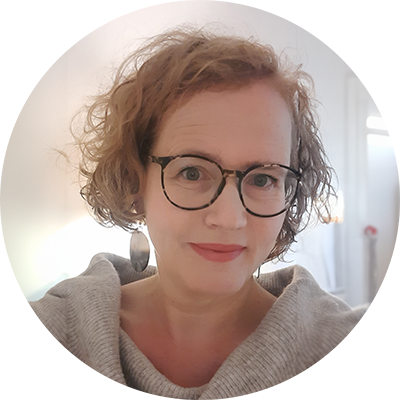
Photo: DBU
"The circular economy offers great opportunities for innovation"
Dr Melanie Kröger, Circular Economy and Bioeconomy Unit at the Deutsche Bundesstiftung Umwelt (DBU), on the circular economy and climate protection, trade fairs and material waste, the circular economy project in the trade fair industry, practical recommendations and circular business models.
This topic also concerns Prof. Dr Kim Werner and Prof. Dr Kai-Michael Griese at Osnabrück University of Applied Sciences. The two professors therefore submitted the project Circular Economy in the Trade Fair Industry to the German Federal Environmental Foundation (DBU). With success: the German Federal Environmental Foundation is funding the project from December 2024 to November 2026 with almost 150,000 euros. Kai-Michael Griese, Professor of Business Administration, in particular Marketing with a focus on sustainability management, outlines the DBU project in one sentence: "We want to analyse circular business models in the trade fair industry with regard to their resource efficiency and environmental impact in conjunction with the Nexus approach and derive concrete recommendations for action."
Consider the nexus approach
Linking the circular economy with the nexus approach promises new solutions for the sustainable use of resources. While the circular economy aims to avoid waste by reducing, recycling and recovering materials, the nexus concept focuses on the interdependencies between resources.
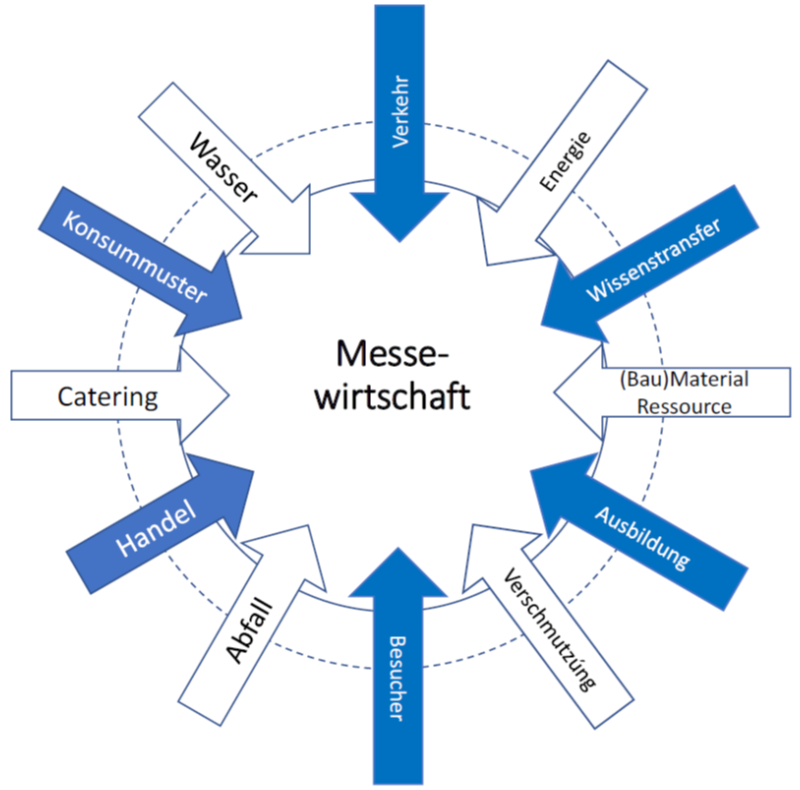
The trade fair industry nexus means that the circular trade fair industry is closely linked to water, energy and raw materials security. Graphic: Osnabrück University of Applied Sciences
The nexus within the exhibition industry highlights the close interconnection between the circular exhibition model and the security of water, energy, and raw materials. Measures in one area can directly impact the others— for example, recycling plastic requires both energy and water. "Until now, these two concepts have been developed separately. In our project, we aim to harness the potential and synergies of both approaches," emphasizes Prof. Dr. Kim Werner, Professor of Business Administration with a focus on Event Management at Osnabrück University of Applied Sciences.
Develop new business models
"The concept of the circular economy helps to reduce waste and emissions, counteract the increasing scarcity of natural resources, develop innovative circular business models and, above all, create jobs and significantly reduce costs for events in the long term," says Kai-Michael Griese, explaining the relevance of the circular economy, which stands in contrast to the current, linear economic model: the throwaway economy. The focus of the two colleagues on the topic of the circular economy in the trade fair industry is also driven by the goals of the European Green Deal from 2019 and 2020. "With this project, we aim to support the objectives of the European Green Deal, not only focusing on waste management but also addressing the design of trade fairs from the very beginning of the production chain," says Kim Werner. The project aims to highlight the potential of a circular exhibition industry: more durable and innovative materials and products, cost reductions and increased competitiveness, a high degree of innovation and a positive contribution to reducing CO2 emissions and conserving resources. "The advantage is that you can demonstrate the potential of the circular economy in the trade fair industry in a very concrete way - e.g. using a trade fair stand," says Kim Werner. It is important to her that all relevant stakeholders are involved.
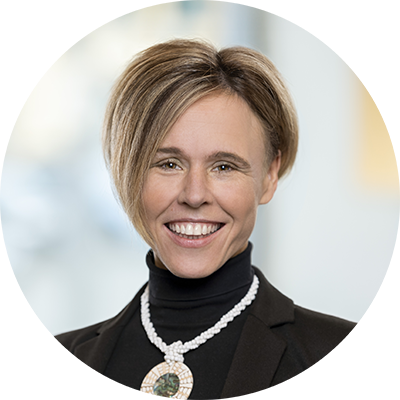
Photo: Osnabrück University of Applied Sciences
"People come together at events. This harbours great potential for us as an industry to show many people how things can be done differently and how we can work together to contribute to a more sustainable future - not just for our industry, but for society."
Prof Dr Kim Werner, Professor of Business Administration, in particular Event Management, at Osnabrück University of Applied Sciences
Breaking down barriers
To this end, Werner held initial discussions with stand builders, which revealed that only a few customers were willing to bear the initial costs for circular exhibition stands. Furthermore, the time pressure involved in planning trade fairs hindered long-term planning for circular concepts—at least in the first instance. "Introducing a circular concept means a lot of effort, as all processes, system components, purchased parts and services have to be checked in detail for circularity both within the company and with the partners," summarises Kim Werner. She concludes: "This complexity and the lack of the necessary competences in the companies act as an enormous barrier." Obstacles are to be identified and overcome as part of the project.
The work packages
The two-year DBU project consists of two work packages. In work package one, the significance of circular business models in the trade fair industry will be analyzed by February 2026. This will be achieved through a literature and best-case analysis, an empirical study involving a survey of circular economy experts to identify success factors in the trade fair industry, and a stakeholder analysis to assess the attitudes towards the circular economy of relevant groups such as consumers, trade fair visitors, exhibitors, trade fair companies, agencies, builders, and AUMA (the Association of the German Trade Fair Industry).
Work package two is set to develop concept ideas by November 2026. In phase one, a material flow analysis will be conducted to track material flows for products, processes, and services. Discussions will focus on key questions: Which materials are required where, and at what energy cost, for the construction of an exhibition stand? What quantities of waste, emissions, and recyclable materials are generated? How can non-circular materials be reintegrated into the cycle? In line with the nexus approach, water, energy, and food utilization will be examined separately. In phase two, an agency will develop creative proposals for implementation, which will be discussed for feasibility at a workshop meeting and refined if necessary. In phase three, the results of all analyses and the case study review will be integrated into recommendations for action and a guideline. These results will be published and presented at specialist events and conferences. Professor Griese emphasizes that for the successful transfer from science to industry, it is crucial to address the specific needs of those responsible in the trade fair industry: "Our results must always solve a concrete practical problem. Therefore, it is essential to closely involve practitioners in the research process."
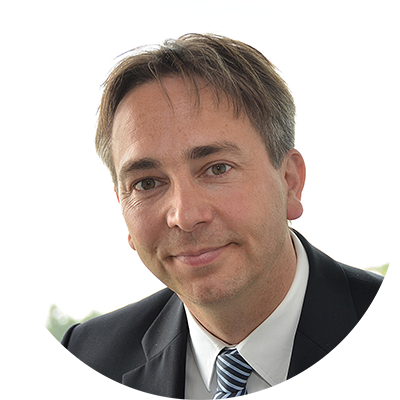
Photo: Osnabrück University of Applied Sciences
"Our results must always solve a concrete, existing practical problem. It is therefore important to integrate the stakeholders from the field very closely into the research process."
Prof. Dr Kai-Michael Griese, Professor of Business Administration, in particular Marketing with a focus on Sustainability Management, at Osnabrück University of Applied Sciences
Partners from the field
Professor Werner emphasises: "We are carrying out the project together and very closely with our practice partners. With their experience and expertise, we are working on concrete proposals for solutions that can be implemented immediately and can change the practice of the trade fair industry in the long term." The practice partners are the AUMA - Association of the German Trade Fair Industry and the members of the Circular Collective from the CSR agency 2bdifferent, the trade fair architects imb troschke and the tw tagungswirtschaft. Their pilot project for a circular exhibition stand aims to realise an exhibition stand based on the principles of the circular economy by IMEX 2026.
The recyclable exhibition stand
The CSR agency 2bdifferent, the trade fair architects imb troschke and the tw tagungswirtschaft of dfv Mediengruppe are planning the tw stand at IMEX in Frankfurt until 2026 according to the principles of the circular economy. The project is being supported by Osnabrück University of Applied Sciences, Faculty of Business, Economics and Social Sciences / Department of Business Administration, Event Management. The contact person is Prof Dr Kim Werner. All three pillars of sustainability (ecological, social and economic) and their fields of action are being analysed. The project is intended as a pilot for the event industry, is designed to be transparent and will be prepared cross-media. Contact persons are Dr. Christoph Soukup and Jürgen May from 2bdifferent, Andrea Walburg from imb troschke, Simone Hammer and Kerstin Wünsch from tw tagungswirtschaft.
Jürgen May, founder and Managing Director of 2bdifferent, advocates for involving the organizing industry. "We need to create a triad where cooperation between stand builders, the companies awarding the contracts, and the trade fair organizers is given proper consideration." His colleague and circular economy expert, Dr. Christoph Soukup, emphasizes the importance of aligning with the EU's circular economy goals and staying mindful of EU regulations. Exhibition architect Andrea Walburg acknowledges that many players are overwhelmed by tenders. She and the other project partners share the concerns of Barbara-Maria Lüder, Manager of Legal, Taxes, Technology, and Sustainability at AUMA: "Designing lean implementation proposals and increasing motivation among practitioners for the circular economy." Project sponsor Dr. Melanie Kröger supports the involvement of practitioners, highlighting that successful DBU projects are characterized by their innovative strength, practical feasibility, and sustainable impact. Kröger explains, "Ideally, a DBU project is the first time that an innovative, environmentally friendly solution has been implemented in practice."
New for our international readers:
For the first time, we are offering an English version of our magazine in addition to the German edition. The translation was made with the help of AI and is currently in the test phase. We’d love to hear your feedback on this new service!